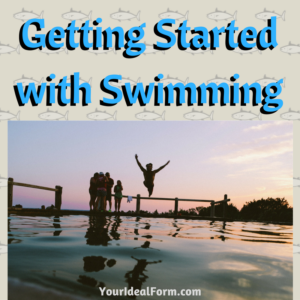
So, perhaps running is not for you. You’ve tried it and hated it, or perhaps your joints really don’t like the impact. Swimming may be the workout for you.
Swimming is unique in the cardio world. For one, it gives you a full body workout. You aren’t just propelling yourself forward with your legs, but you are using your arms as well. Because you are surrounded by water, you don’t get all sweaty and gross like you would with other exercises. While it is a nearly zero impact workout, it is certainly not easy! If you have access to an indoor pool, you can swim year-round.
Caveats
Which leads us to the caveats for swimming. It can be easy to overdo it in the pool. The water keeps you cool and washes away your sweat, so it’s easier to keep going for longer. If you are just starting out and not a strong swimmer, be sure there is a lifeguard present! Always consult your doctor before starting a new exercise regimen.
Learn to swim
The first step is being able to swim a lap. Most lap pools are 25 meters from one end to the other. Olympic-sized pools are 50 meters long. If you do not know how to swim, or cannot swim an entire lap, or perhaps you don’t know the “proper” way to do the freestyle or front crawl stroke, then you need to start out with some swim lessons. Head on down to your local recreation center or YMCA and see what swimming lessons they offer. As you progress through the lessons, you will learn the proper way to do the main swimming strokes: backstroke, breast stroke, freestyle (or front crawl*) and even butterfly. You’ll also learn the proper breathing techniques to keep you as streamlined as possible while also getting enough air.
Build up your endurance
Once you can comfortably swim 50 meters, you can start building up your distance to get in a longer workout. This is easier in a standard pool, since adding 25 meters at a time is easier than jumping up 50 meters at a time. Building up distance in swimming is different than running. With running, you can always slow to a walk. With swimming, you can only slow down so much. It’s really either swim or sink. Most swimming programs will have you swim a certain distance, then take a rest at one end or the other. As you progress, your swim time gets longer, and the rest periods may get shorter.
For true beginners, there is a 0 to 700 program. It starts you off very slowly, then builds distance until you are swimming 700 meters in a session, although not all at once.
Go the distance
Once you are ready to progress further, or if you already have a decent cardiovascular base and are a decent swimmer, you can move up to the next level. A program I have used in the past is the 0 to One Mile swim plan. It starts off with a 700 meter day (not all at once though!) and then builds to a “swimmer’s mile” which is 1650 meters.
What you’ll need
To get started with swimming, you’ll need some equipment. Of course you’ll need a place to swim, and you’ll need a proper swimsuit. A good swimsuit will let you move through the water without creating drag, giving you a wedgie or, heavens forbid, getting loose and coming off mid-stroke. Goggles are also a must for protecting your eyes from the chlorine and letting you see where you are going. A swim cap is not necessary, but it helps prevent the strap of the goggles from pulling on your hair, and can help minimize chlorine damage to your locks.
Do you have any questions about swimming for exercise? Let me know in the comments!
* The stroke is technically the front crawl. Back in the day, in the Olympic “freestyle” event, swimmers could choose their strongest stroke for the race. Because front crawl tends to be the fastest for everyone, that’s the one every swimmer chose, so now, freestyle is synonymous with front crawl.